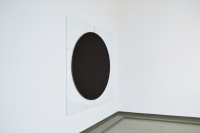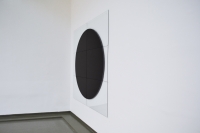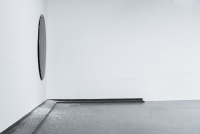A je tu zas? Slovenský štát v súčasnom umení
4. 11. 2016 – 26. 2. 2017- Kunsthalle / Bratislava
ARTALK - Výstavný aktivizmus
Dalibor Bača vo svojom projekte Ozvena realizoval sochársky objekt zložený z dvoch samostatných
štvorcových platní, ktoré sú vytvorené lepením skla a asfaltu. Vpísaný kruh pri oboch z nich tvorí
podklad pre kresťanský kríž a v druhom prípade pre gardistický znak. Oba objekty sú inštalované
proti sebe a kombinácia skla a asfaltu spôsobuje ich vzájomné zrkadlenie, ich vzájomnú vizuálnu
ozvenu. Jej presnosť či premena je závislá od uhla pohľadu diváka. Dôležitým momentom je aj
vstup návštevníka medzi obe platne a jeho odraz v nich. Oba znaky reprezentuje Slovenský štát,
vzájomnú kolaboráciu cirkevných hierarchií so štátnou mocou. Pre Slovensko je už od 19. storočia
charakteristické vstupovanie katolíckych kňazov do politiky. Ich záujmy smerovali spočiatku k práci
pre národ, národnobuditeľským aktivitám, postupne však razancia ich hlasu silnie, stáva sa
autoritatívnym v presadzovaní nielen vlastných predstáv o svete, ale aj poriadku v ňom. V
súčasnosti sledujeme vzájomné „porozumenie“ medzi politickými reprezentáciami a katolíckou
cirkvou. Sme svedkami prepojenia katolicizmu a nacionalizmu, tak ako tomu bolo v
čase Slovenského štátu. Aj dnes táto spolupráca generuje negatívne hodnoty, ktoré zamietajú
všetko „neslovenské“, šíri netoleranciu a strach z ľudí na úteku či z komunít, ktorých identita je
postavená na inakosti.
In his project Echo, Dalibor Bača implemented an sculptural object composed of two independent
quadratic plates formed from gluing glass with asphalt. The inscribed circle in both of them forms a
base for a Christian cross and a Gordian symbol respectively in the other case. Both objects have
been installed opposite each other and the combination of glass and asphalt generates their mutual
reflexion, their mutual visual echoing. Its accuracy or rather transformation depends on the viewer’s
angle of the view. An important aspect is the entry of the visitor into the space between the plates
and his/her reflection in them. Both of the signs represent the Slovak State, mutual collaboration of
the church hierarchies with the state power. Since the 19th century in Slovakia it is characteristic
that Catholic priests assume political activities. Initially they pursue work for their people, national
revivalist activities, gradually, though, the vigour of their voice grows, and it becomes authoritative
in pushing through not only their views of the world, but also of the order therein. At present we
are noting mutual „understanding“ between the political representatives and
the Catholic Church.We are witnessing interconnection between Catholicism and nationalism,
as it was the case at the time of the Slovak State. Also today this collaboration generates negative
values that defy anything „non-Slovak“, disseminates intolerance and fear of people on the run or
of communities whose identities are based on the otherness.
Bohunka Koklesová


